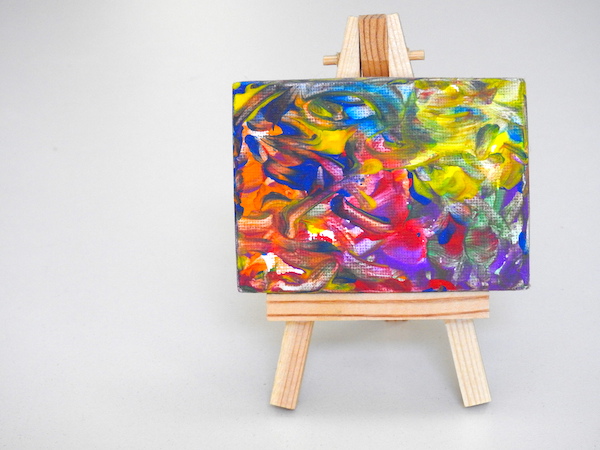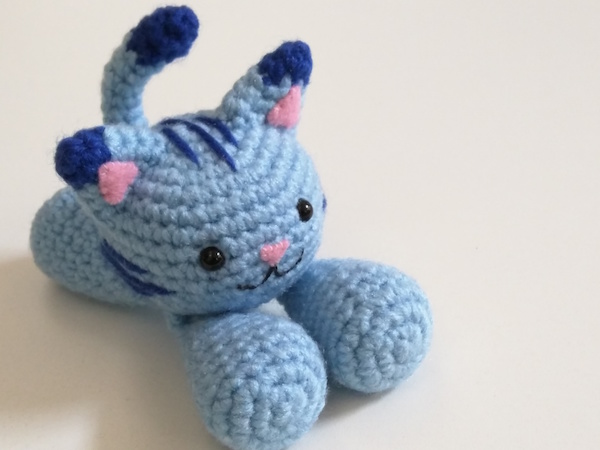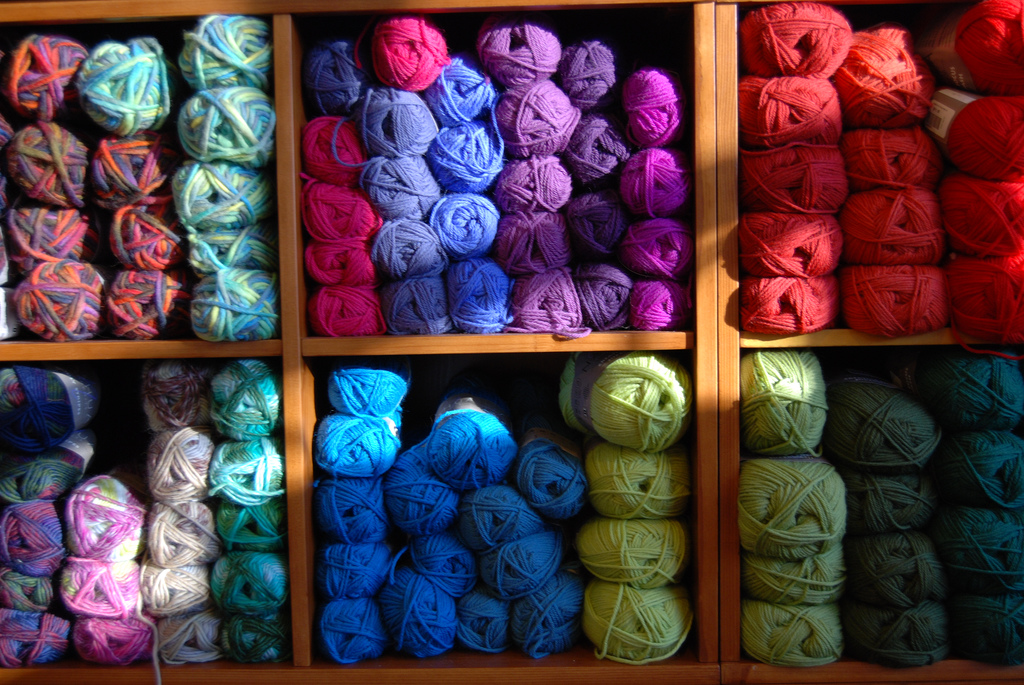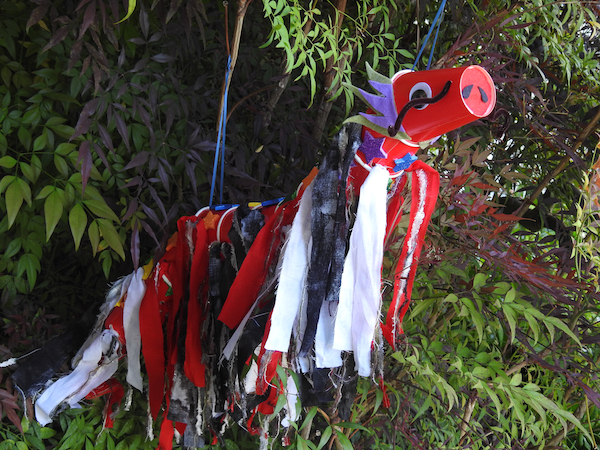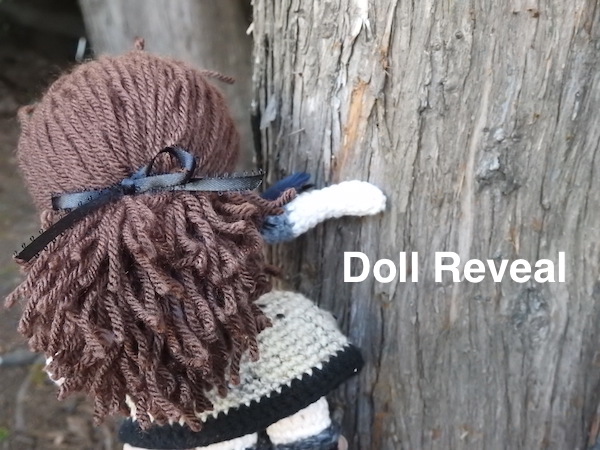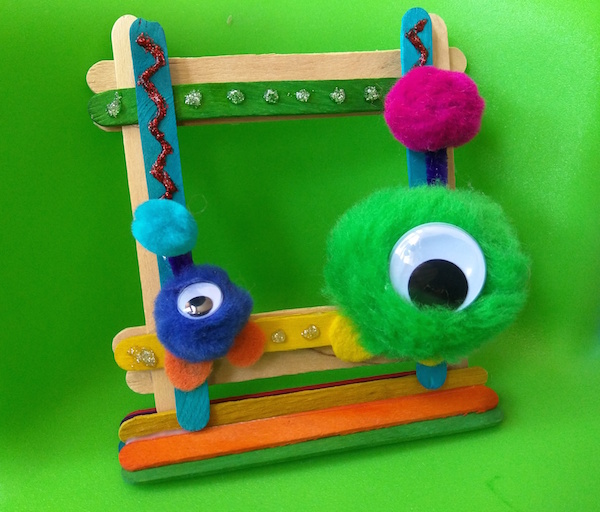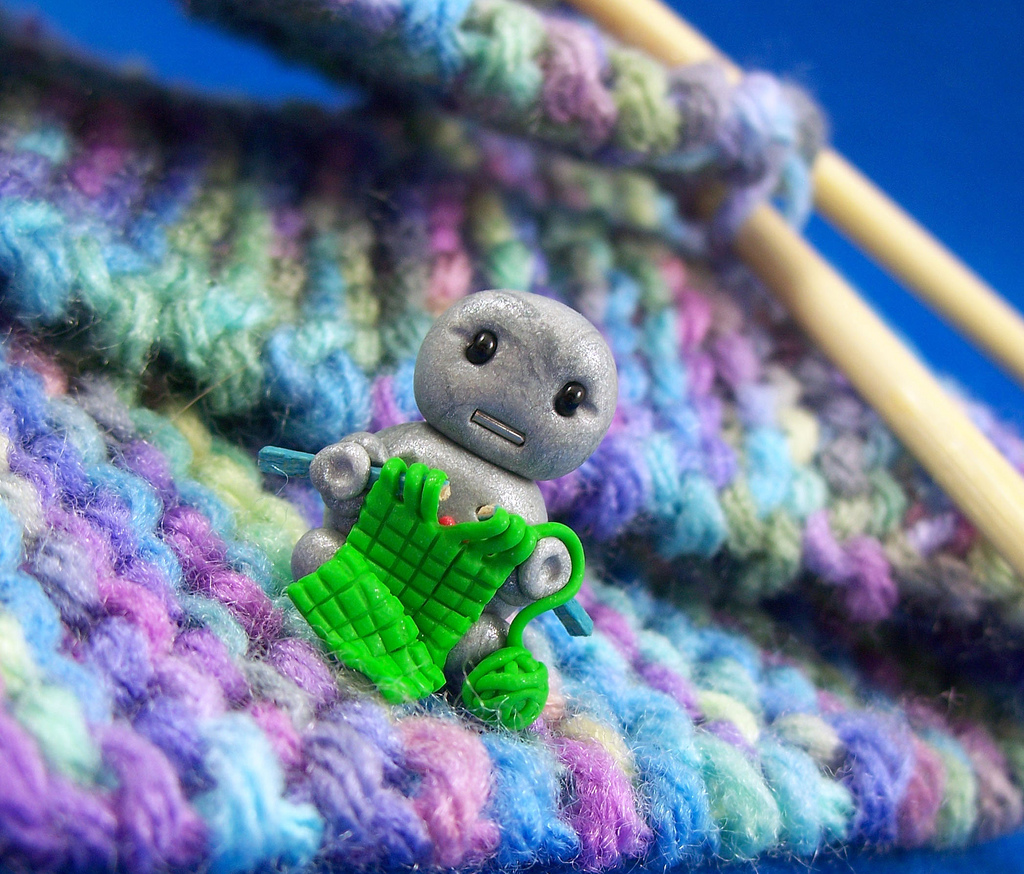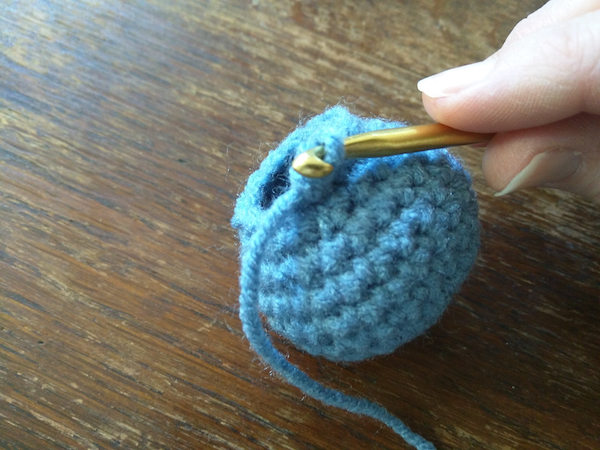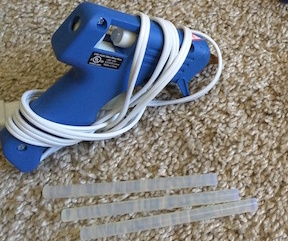-
Craft for Kids: Finger Painting
When my son was only about a year old, we went to a birthday party where my friend had organized a craft for the kids. She’d provided small (8×10) canvases and Crayola washable paint, and had lined her entire living room floor with butcher paper. Her hope was that the kids would use their hands to make paintings and there would be minimal mess afterward.
-
-
What I am Working On : Decrease and Invisible Decrease Videos
I thought it high time to post a couple more How to Crochet Amigurumi videos on my
Ink & Stitches YouTube Channel
-
Dragon Craft Project : Fun with Kids
When this book, Fun Things to Do with Paper Cups and Plates by Kara L. Laughlin, came through the library where I work, I had to take a minute to thumb through the pages. The cover was too cute to let it slip through my fingers without a glance!
There are lots of fun crafts to do with your kids in this one, but my son is only 2 1/2 years old, so the project would have to be basic. Unfortunately, my favorite craft from the book that I just had to make, was the dragon (a bit advanced for a two year old) made with paper cups.
I had a few ideas as to how James could participate during this project, as well as some alterations and additions I planned to put in, that differed from Kara’s original design.
The first way James could help me was to pop the holes in the center-bottom of each cup. Don’t worry, I didn’t give him any sharp objects! I actually used a small meat thermometer for lack of options. I held the thermometer steady, and he pushed it down into the cups to make the holes. Let’s just say, he kept wanting more cups even though we’d already popped holes in the eleven we needed for the project. Hadn’t considered that one!
The first alteration I made was how I did the tail cup. I ended up not wanting it to be open and instead had the last two cup openings facing each other. To keep them from coming apart, I got out my trusty hot glue gun and glued them together (see my
H is for Hot Glue and Rock Sculptures
-
New Video: Adeline Doll Reveal!
In order to change her destiny and the barren, colorless world, ten-year-old Adeline will have to unleash the last bit of magic.
Adeline Picot, is the main protagonist from my Middle Grade Fantasy story, Adeline and the Mystic Berries.
I have talked about the book on and off, and, as you know, I am now working on re-editing the story before I continue querying to find a literary agent.
In the meantime, I couldn’t wait to begin crocheting up some of the characters from this story that is very near and dear to me. It was the first book I ever wrote, and the first time an idea struck in my head that stayed.
I had always thought being a writer would be a wonderful job to have, but prior to coming up with the idea for Adeline and the Mystic Berries, never thought I would ever have good enough ideas myself. She proved me wrong, and here we are.
My vision is to have a line of dolls from the book that other crocheters can make. I want readers who love the story, to be able to have their very own dolls from the book!
So, without further ado, here is a video I made for my
Ink & Stitches YouTube Channel
-
A to Z Challenge: P is for Popsicle Stick Picture Frame Craft
I was asked by the library where I work, to come up with some craft projects for kids. These were to be done at a “Crafts” booth for a local event the city was putting on.
I came up with two different crafts for the kids to choose from. One of the two was a Popsicle stick picture frame whose construction pattern came from DIY Family: The Wonderful World of Crafts. I have included my pictures below on the assembly as well:
You could choose to use the natural wood sticks if you want a more earthy look to your frame, or you could go wild and pick out the colorful sticks that come in all the colors of the rainbow. Since kids love color, I went with the colorful ones for the event.
The construction of the frame was ingenious and because of how the stand and frame are built, the frame can be used for a picture that is either portrait or landscape. If you have a picture in mind before you begin, you will better know how to decorate your frame (and where to put that little 1/4 stick, which is what holds the picture in place). Directions for the stand aren’t included here. You can find them, as well as detailed instructions for the frame, by following the link at the beginning of this post.
Decorating is where the fun begins!
I made several examples to show the kids. I had a caterpillar with some leaves, a cat one for cat-enthusiasts, and a monster one because, why not?
You can use whatever supplies you have to decorate: glitter, glitter pens, sequins, beads, felt, puff balls, pip cleaners, googly eyes, construction paper to draw on, etc.
You will need scissors and craft glue as well (hot glue can be used – see also,
rock sculpture hot glue craft
-
A to Z Challenge: M is for Making Amigurumi Patterns
Once you get comfortable working up other crafter’s patterns, why not try making your own? You will begin to understand how increasing and decreasing stitches can change the shape of your piece while crocheting in the round. I made other crocheter’s patterns for about two to three years before feeling confident enough to make my own.
Fair warning: just like in writing stories, there is always revising in pattern writing and it often takes making rows and ripping them out several times before you get the shape just right. I have included a picture of my pattern writing process for you here, to illustrate what I mean. Sad to say, the center picture is not my own and has nothing to do with the pattern. I just wrote the pattern around it. The leaf is what I was working on making here.
Looks a bit scary doesn’t it? Let me just say this though, even after crossing out and reworking each piece, I eventually got it just the way I wanted it. The end result is always worth the revisions made to get there.
When you look at a character you want to make in crocheted form, the first thing you should do is break down the character into its most basic form: shapes. You will find many patterns will be made up of: circles, ovals, cylinders, half-circles, triangles, etc. Once you make the separate pieces, you will be able to give the amigurumi heart by embellishing with buttons, safety eyes, embroidered details, felt, etc, in order to bring out the character within the character.
How?
Why don’t we take a look at one of my basic patterns together? I have drawn up a very simple floppy-legged cat here:
Now let’s separate this character into its basic form, picking out the shapes that make up the whole picture. Below are the kinds of sketches I draw up to do this, when I am going to be coming up with a new character.
I break up the details so that I know where I plan to embroider, use felt, add poly pellets (little plastic circles generally used to stuff the bottom of the legs or body, in order to add weight), stuffing, etc.
Easy so far? Not too bad right? Let’s focus in on each piece, one at a time. The head of the cat is a circle. Circles are very common in amigurumi and they are also fairly easy to make.
Making a Circle:
Often you will see patterns for circle shapes beginning with: 6sc (single crochet) in a magic ring – 6 (row ends with 6 stitches); from there, you increase in all stitches: inc around – 12; then begin the pattern: (sc, inc) around – 18; (2sc, inc) around – 24; (3sc, inc) around – 30; etc, until the head measures the circumference you want.
You can now begin single crocheting around to build up some of the height of the head. This is equivalent to more rows than you made during the increasing portion of the circle, if you’re looking to make a perfect circle. Once those are in place, you decrease (I like to use the
invisible decrease technique – invdec
-
A to Z Challenge: K is for Knitting vs Crocheting
If someone asked me which I prefer: crocheting or knitting, I would tell them without batting an eye, crochet, every time. Let me tell you why.
The differences between the two are like comparing a manual transmission vehicle to an automatic. In a manual car, you use two feet to drive. Automatics use only one.
Some people swear by manual transmissions, loving the control they give and the extra power that comes along with that.
Let’s just say, I never learned to drive a stick.
I prefer using only one foot to drive, as much as I prefer to use one hook to crochet instead of the two needles it takes to knit (sometimes more if you are working with double-pointed needles in the round).
Crocheting is just easier for me. If my hook falls out of the loop, and a stitch is dropped in the process, I can pick back up the previous loop on my hook and begin working into the next stitch again. No harm done. No hearts need to stop or breath needing to be held, while I search for my lost stitch.
When I knit, a dropped stitch could be disastrous! The little buggers can easily get eaten by the tangled web of stitches from the previous row. If I had done a purl stitch instead of knit stitch, as the pattern had called for, in a previous row, trying to go back to correct the visible error my mistake created, wouldn’t be as easy as it would be if I’d been crocheting the same piece.
In knitting, my fixes would consist of attempting to reverse knit in order to backtrack to the error in question; I could also take the stitches off the needles completely and unravel the working yarn until the row with the error is found. Once I reach the row with the error, I can pick up the prior rows stitch loops one-by-one onto my knitting needle, as I unravel the final stitches leading to the problem area.
Both options prove difficult.
With crocheting, especially when making amigurumi, all you have to do is pull the working yarn to unravel each row, backing the stitch marker to the prior rows start each time you reach it. Once you’ve back-tracked far enough, you can just pick up the one loop available and begin crocheting into the next stitch again.
With the stitches being worked one-by-one instead of having them all active on a knitting needle, crocheting is so much simpler in my eyes.
Not to say that I haven’t spoken to many people who find knitting an easier feet than crocheting. I even have friends that feel this way, who are avid knitters. They acknowledge the annoyance that happens when you drop a stitch, but they would choose knitting over crocheting any day.
Having told you my difficulties with knitting and admitting that I would pick crochet as my favorite any day of the week, I will say this: I still knit. I love knitting.
Will I be making my own patterns up in the near future? Probably not.
I don’t have that large a grasp of the medium to create something never been made before. For pattern-making, I will stick with making up crochet amigurumi patterns (see post for Making Patterns). I will still make other crafter’s knitting patterns as gifts for people. I love making slippers, ever since my mom passed the slipper-making torch over to me when her hands needed to give up knitting. My dad has had the same homemade slippers made for him since as far back as I can remember; made with tassels every time. I’m not going to be the one to stop that tradition.
I’ve made a shrug and blanket in the past as well. Knitting is very relaxing to me if the pattern is fairly simple. Someday, when there’s more time, I hope to make myself a sweater (preferably with pockets). A scarf would be nice too and maybe a pair of fingerless gloves. When it comes to making clothes, I would pick knitting over crocheting any day.
For my amigurumi though, just leave me with some yarn, a stitch marker, and a size E crochet hook, and I’ll be good to go. Oh, and a pair of scissors would be nice! Thanks.
Which do you prefer: knitting or crocheting? Why? What is your favorite thing that you’ve ever made with yarn?
Enter to win the A to Z Challenge Giveaway (amigurumi crocheted dog) here.
-
A to Z Challenge: I is for Invisible Decrease (Crochet)
I had been crocheting for a couple of years before ever hearing of a stitch called: invisible decrease. Decreasing wasn’t a mystery to me. I had learned to decrease (combining two or more stitches into one) at the same time as I’d learned to increase (adding one or more stitches into the same working stitch).
Before I get into what an invisible decrease is, I want to explain what a decrease of any kind will do when crocheting amigurumi. The purpose of a decrease stitch is to lessen the number of stitches in a row, or round in this case (as amigurumi are worked in the round). By doing this, you begin to close the hole of the piece you are making.
For example, if you are making a circle (to make things easy), decreasing would occur once you’re over halfway through the circle and you are beginning to round off the other side, thus closing the circle (remember not to forget to stuff before the hole gets too small).
Decreasing is the opposite of increasing. Increasing would be the part of the circle when you are just beginning to build up to the size you want your circle to be. By crocheting more than one stitch into the round prior, you are enlarging the round. To make an amigurumi circle, you would want the increases and decreases to be even all the way around. This prevents the circle from becoming anything but perfectly round.
In addition to the single crochet (sc), increasing (inc) and decreasing (dec) are the two most commonly used stitches in crocheting amigurumi. You can sometimes work through an entire pattern with only those three stitches under your belt.
When I saw the abbreviation, “invdec,” come up in a pattern, I immediately had to go to my trusty YouTube to figure out what that meant.
Any time you come across a term or a stitch that you’ve never heard of, I encourage you to go online. I prefer watching videos, because then I can see another set of hands making the stitch, while I am working to do the same with my own. Believe me, I wouldn’t steer you wrong here. You can get by looking at pictures that step you through the process as well, but the videos have been a life saver for me!
Invisible Decrease (invdec), as I came to find out, is a way of decreasing that allows the decrease stitch to be practically invisible. To a trained crocheter, you can still find them, but to anyone else, it is a much cleaner method of decreasing.
To illustrate the difference between a standard decrease and an invisible decrease, here are two pictures for reference. As you can see, the first one is the standard decrease and it leaves a larger, more noticeable stitch. This creates a bump in the piece, so not only can you see the decrease, you can also feel it as well. With the invisible decrease (seen here in the second picture), you can barely see that there’s been a decrease made at all.
Invisible decreases are made using the front loops only (FLO) of the prior round. By working in only the front loops, you are taking away some of the bulk (by leaving the back loops un-worked) that a decrease would normally create.
Step-by-step Instructions to Make the Invisible Decrease and Pictures to Illustrate:
-
A to Z Challenge: H is for Hot Glue and Rock Sculptures
I remember a time when my dad used to help me with my crafts that required use of a hot glue gun. They certainly do get hot, but it’s amazing what you can create with them!
I’ve made Popsicle Stick picture frames (see post later this month on making one yourself), sock puppets (more on this to come in April), and fun rock sculptures as well. There is really no end to what you can create with the use of a hot glue gun!
You may get a few burns along the way, especially if you’re klutzy like me, but it’s always well worth the resulting 3D art! Speaking of which, I’d like to share with you how to make one of those rock sculptures I was talking about.
Let’s Make Something Fun! Caterpillar Rock Sculpture
